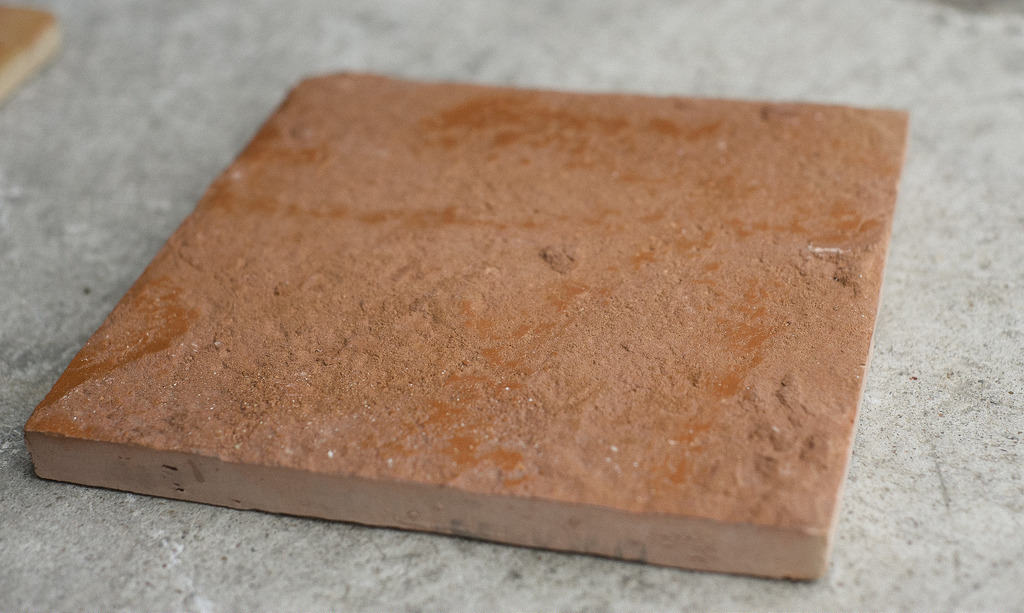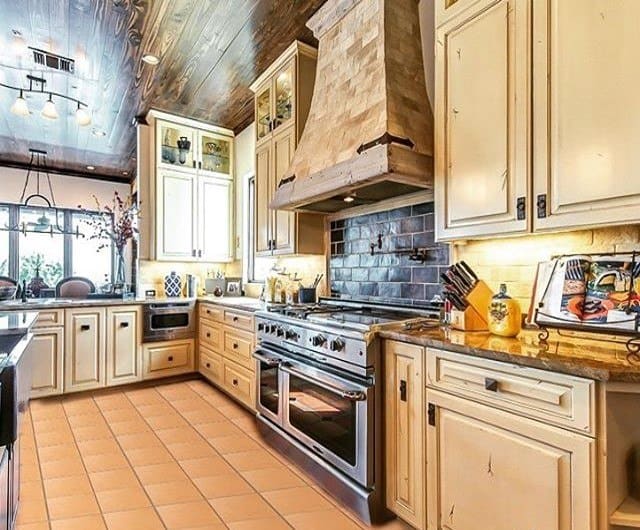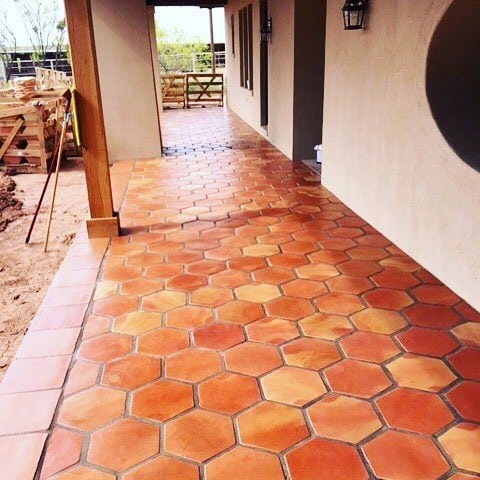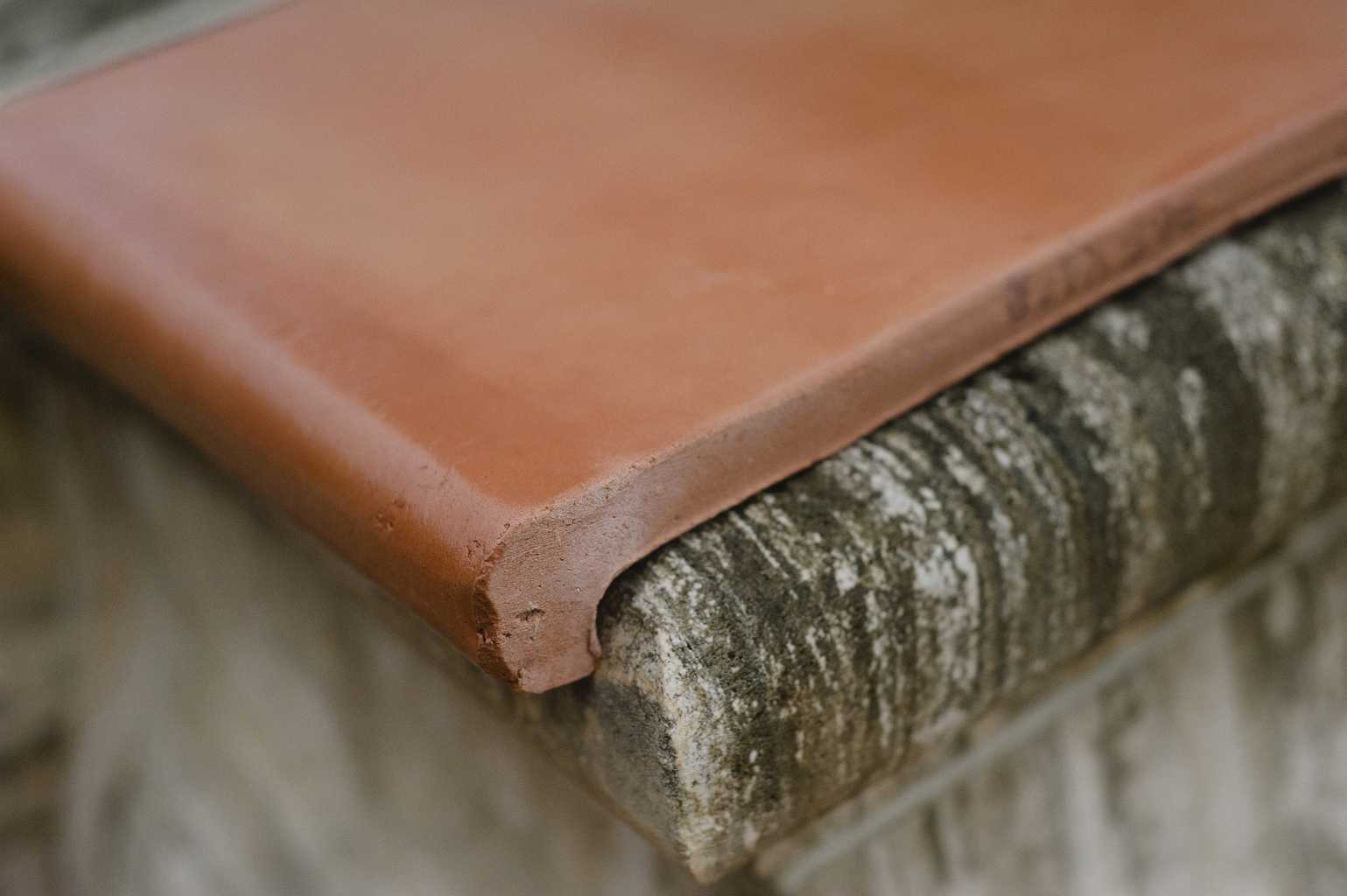Saltillo Mexican tile has been used in homes in Central and South America for hundreds of years. Though not durable enough to withstand harsh winters outside, these tiles are lovely indoors anywhere. The challenges of this type of flooring include installation of Saltillo tile, restoration of Saltillo tile, and maintaining Saltillo tile. But the benefits — rustic beauty, non-toxic materials used to manufacture, and low cost — may outweigh any drawbacks.
Bring the beauty and peace of Mexico to your home with Saltillo floor tiles. When paired with the right décor, Saltillo tile can have a bit of an exotic feel. It also makes for great solar mass for homes using passive solar energy!
Many choose Saltillo tile due to the:
- Natural beauty of the tiles themselves.
- The non-toxic materials used to manufacture the tiles.
- The low-cost of the tiles for the high end look.
Saltillo tile has its challenges, which include:
- The tiles themselves are extremely fragile.
- Maintaining and cleaning the tiles is tedious.

(Photo credit: Rustico Tile and Stone)
What is Saltillo Tile?
Saltillo tile is a type of terra-cotta tile made only in northern Mexico. These tiles are made of natural clay that is first shaped by hand and then dried in the sun. Saltillo tiles are then kiln fired to ensure hardness and durability. The tiles are carefully positioned in the kiln in order to create different colors. Depending on the tile position in the kiln, the resulting tiles can range in hue from pale amber to dark terra-cotta. Traditionally, Saltillo tiles are left unglazed, although some manufacturers sell them pre-treated or pre-sealed in order to increase their durability.
Naturally, Saltillo tile is not terribly strong or hard. Although it is comparable to other natural stone tiles (such as slate or granite) it can chip and crack. When used as exterior tiling, it can only be used in very mild climates, as harsh weather can damage the tile. Really, Saltillo tile should not even be used indoors in places that are particularly cold, as they will not be able to hold up in the face of colder temperatures. Saltillo tile typically has a MOH (measure of hardness rating) between a 3 and 4, which is fairly low (compare to porcelain, which has an average MOH of 7-9). Therefore, it is very rarely used for outdoor purposes these days, though it very warm climates, well maintained and sealed Saltillo tile makes for a nice tile flooring option for a patio. However, the elegance and beauty Saltillo Tile brings to the interior of the home more than makes up for its lack of strength and hardness.

(Photo credit: Rustico Tile and Stone)
Installing Saltillo Tiles
Installing Saltillo tile also has to be done carefully, as the tiles are delicate. Any grout or chemicals spilled on the tiles can damage them, so it is crucial to keep the tiles covered with paper until the installation is complete. This is not typically something that you will want to attempt yourself unless you have a good bit of experience with tile installation and feel confident with your abilities. However, because individual Saltillo tiles are so inexpensive, you can take a little liberty and losing one or two tiles during installation will not obliterate your flooring budget.
Prior to starting installation, you will need to make sure the subfloor is perfectly prepared. The flooring must be perfectly level and there are no cracks, holes or misalignments where moisture can get trapped. The tiles can be laid starting in one corner of the room or starting from the middle of the room, but the last row of tiles will need to be cut carefully to fit. Once the tiles have all been laid, a sealer will need to be applied, then a grout, and finally at least a second layer of the sealer.

Sealing Saltillo Tiles
Saltillo tile was introduced to Mexico by Spaniards hundreds of years ago, and the process of making the tile has remained the same since. The tile is actually named after the Mexican town of Saltillo, which produces the right clay and weather for making this popular tile.
As Saltillo tiles are fired at such low temperatures, they remain very porous and are therefore very susceptible to water damage. It is almost exclusively recommended these days that you seal Saltillo tiles to protect them from water, wear, and scratches. Typically, Saltillo tiles should be sealed after they have been installed and are completely dried and clear of extra dirt and debris. You will want to decide primarily how much shine you are wanting from your floors and choose a level of gloss or matte for the sealant and polish appropriately. Sealant should be applied in several coats, and the number of coats can vary depending on the manufacturer’s recommendation.
Maintaining Saltillo Tiles In the Home
Saltillo tile in the home has a few drawbacks. Regular sweeping is one of the best ways to maintain the Saltillo tiles in your home. While some recommend vacuuming, regular vacuuming could chip the tile, which is why sweeping is really the preferred method for daily maintenance. For a deeper cleaning, unsealed and untreated tile needs to be laboriously cleaned with diluted ammonia and “elbow grease”, and lots of rinsing. Saltillo tile floors need stripping and resealing, before and after cleaning to do a proper job. It is important to also wipe up any spills and dirt right away, as the tiles can stain. If the floor is ever flooded, the delicate tiles will be severely weakened. Only slightly damp mops can be used on the floors, and only the very mildest cleansers (no harsh chemicals). Also, a sealant will have to be reapplied regularly to keep the floor in good condition.

(Photo credit: Rustico Tile and Stone)
If you are planning to refinish Saltillo tiles, you will need to make sure any previous polish or sealant has been completely stripped and all that remains is the basic Saltillo tiles. To strip the tiles, you should use a gentle solvent and a soft bristle brush to prevent damage to the tiles themselves. Also, when refinishing, a new grout will have to be applied along with the new sealant.
Why Choose Saltillo Tile
Despite these disadvantages, there are many benefits to selecting Saltillo tile for your flooring needs. Primarily, Saltillo Mexican tile is beautiful and offers design flexibility. Whether you have a modern home, a country French-style residence, or love the Mediterranean style, the natural beauty of Saltillo tile can make your home truly stand out. Although this tile requires a little more effort to care for, many homeowners and decorators feel that it is well worth it for the beauty it brings to any room. Modern sealants do make cleaning and caring for Saltillo tile easier than ever before. The tile itself is comparatively inexpensive and many homeowners like the all-natural products that go into the tile-making process. At a time when we are surrounded by chemicals, it is nice to bring a natural product into the home.
The greatest benefit to Saltillo tile is that, because it is inexpensive, people feel free to experiment with various patterns and designs with the tiles and the results can be truly unique and spectacular. The tiles are readily available via almost all leading suppliers and, therefore, sourcing the product is not difficult at all. There are even blogs dedicated to various Saltillo designs where you can find inspiration and demonstrations of a whole selection of incredible designs. Perusing these visual examples can give you a clear idea as to how you want your flooring to look. If you need further or more specific advice, your Saltillo tile supplier will be able to recommend a few experts who can help you make your choices.

(Photo credit: Rustico Tile and Stone)
In general, natural tile flooring is a beautiful and durable flooring option for your home. If you’re looking for advice on specific tile flooring options, most popular professional companies, such as Lumber Liquidators, are happy to provide information regarding specific tile flooring options or installation and will even do in-home consultations at no charge. If you want a naturally beautiful and affordable flooring solution, consider installing Saltillo tile in your home. It has been trusted by savvy homeowners for hundreds of years. Is it time for you to trust too?

My husband and I purchased a new home in 2002 with concrete patio in front and back. We added to both w/ new concrete. However, we aren’t happy with the look of old vs new and would like your suggestion as to what to use to give them a uniform appearance. In fact, the old concrete looks like it has mud stains in it which my husband tried to remove using acid-concrete cleaner to no avail.
We talked to a friend about putting down Saltillo tiles, but in reading your advice, I believe we should use something else. But what? FYI: Our home is a ranch-style one with old brick facia on the bottom third of the walls with Hardy Plank Boards above. It looks like a cottage style home with drought-tolerant plantings (not cacti and succulents).
I have a big room full of saltillo tile that am either needing to remove or strip/refinish. Do you know of someone in the Houston area who removes tile? I removed about 50% with a demo hammer, but am too busy to finish the job. I need help…can you help me?
Hi Gordon,
I’m sorry, I don’t know of anybody in the Houston area. You might try looking in your local newspaper for a handyman or a contractor who does remodeling.
Hi Mo,
Your concrete may never match due to the fact that you have old & new concrete. Batches of concrete are mixed individually and in your case, there wouldn’t be a 100% in materials used for the concrete (sand, small gravel), these could cause the colors to be different. The only way to have them look the same is to quite literally apply a new layer of concrete over both. I know, not something you wanted to hear.
If you’d like to try cleaning your old concrete in hopes of it being a closer match, you can always try cleaning it with a product like StainSolver — it’s a product similar to OxyClean, but better because it’s got more bleaching action. It’s also environmentally friendly, meaning it’s not going to harm your plants (or pets).
Hi there. I have saltillo tile throughout my home. We moved in 3 years ago and they were in impeccable shape. They are looking a little worse for wear these days. They seem to be stained (regular mop cleaning isn’t doing the trick) and dull. What do I need to do to maintain them?
Also, I have a 6 month old who is just about to crawl. The floors are really hard and chilly and I’m looking for something to cover them in the living room, dining room areas them that. Something we could put our area rugs on top of that will also protect our baby from potentially disasterous falls. Is there anything you suggest? We have 2 dogs as well so cleaning needs to be simple.
Thanks so much!
Myndy
Hi Myndy,
For getting your saltillo back in shape, I’d suggest products made by AquaMix. After that, cleaning is simple – a weak solution of water/vinegar (15 or 20 parts water to 1 part vinegar). Use a microfiber mop and make sure rinse water stays pretty clean so that you don’t deposit dirt back on your floor. You can even use a dry microfiber mop afterwards to kinda buff it.
You can use pretty much any kind of area rug, the big thing is to only use a backing or pad that won’t stick to the saltillo, otherwise your going to have to remove what gets stuck and probably strip the floor. Ugh! I can understand your worry about the floor being chilly for your baby, as far as falls go, kids don’t seem to get hurt by falling down on a floor much – it’s objects on the floor that usually injur them (including furniture). Also bear in mind that you should keep your area rugs very clean as they harbor various allergens.
Good luck!
Are there detailed instructions on how to install saltillo? I live in Phoenix, Arizona(Very hot Summers)- when is the best time of year to install this type of tile?
Hi Mike,
There aren’t ‘detailed’ instructions per se on this site, but there may be another site that does have such instructions. If you read over all the comments (yes, there’s many here!) you’ll learn what to do, what not to do and why. Installation, problems, etc. have been discussed many times here.
Our foyer, kitchen and dining room are all done in saltillo and I really love it. However the living room and hallways that come off of those areas are carpeted with an awful baby blue colored carpet that needs replacing. What type of flooring goes well with saltillo? We would like to try and stay away from carpet and are a little unsure about being able to match the existing saltillo. Any other options you would look into that would accent the saltillo?
Hi Lindy,
Wood flooring (whether solid or laminate) would look nice. Ceramic tile would be another good option, there are wonderful Mexican tiles with bright designs that are just gorgeous.
We need to learn about saltillo restoration. We’re a professional carpet & tile cleaning co. & we have 5 properties that have saltillo around all the swimming pools I can practice on. I know it was a bad move on thier part to install it there. can you help? Stu.
Hi Stu,
Not necessarily a “bad” move, but does require that they keep up regularly with maintaining it. There’s tons of info on this site, there’s lots of posts if you follow the link here. Happy reading!
I laid saltillo in a sun room. It looked very nice until I went to apply a grey grout (cement colored). When I went to remove the excess grout it had stained all of the tile surfaces. The saltillo went from it’s beautiful peach tones, to something that looked like it was smoked stained after a fire! Noting I did would restore the color. What did I do wrong? The tile was not pre-sealed. Was I supposed to apply sealer to everything before applying grout. Can my floor be saved, without having to take up all of the tile. Thanks for any help!
Happy Thanksgiving to all:
I sealed new saltillo tile with 50/50 mix of linseed oil and paint thinner, turned out great. I then coated the tiles with a wax high gloss product, that on all the other floor areas work great. The new tile area is not glossy and gray/ whitesh. What do I strip this with, I have used pool acid and not coming up. I want to startover (only 12 tiles). What do I do?
my home had a flood our saltillo tile floor is currently being resurfaced. The contractor that our insurance company chose to restore our floors have stripped and stained our floors with a water based stain which was horrible. After they stripped it again they will use an oil based stain. What is they exact process they should follow to insure a beautiful finish. After stripping do they clean the floor? Do they seal before staining or stain before sealing it. Also how may coats of each is reccommended. THANKS, MARY
Hi Daniel,
Unfortunately, yes, you should have sealed the saltillo before you grouted, then sealed again afterwards. I don’t know how successful you’ll be in removing the grout that has gotten into the pores of your saltillo. AquaMix has products to do the job so all might not be lost.
Hi Mary,
Pretty much, it’s the manufacturer’s directions that should be followed to help insure that they get the results that are desired. If there’s any cleaning to be done (I really don’t know what kind of cleaning you’re talking about) it should be done beforehand. If you’re referring to deep-cleaning (like with AquaMix’s deep cleaner) then the instructions should be followed. The sealer should be applied after staining and it should be compatible with the stain. As to how many coats of each product, again — follow the manufacturer’s instructions. If you think another coat of two of sealer should be applied though, don’t be afraid to do it.
Hi Shaughn,
Look for BioShield. I have recently discovered this sealer and think it’s a superior product for sealing stone, Saltillo tiles, and wood floors. I like it because it’s made of natural ingredients and doesn’t harm your air quality.
Help! I live outside of Galveston and Hurricane Ike set saltwater on my outdoor patio with Saltilo. The top coat is peeling, looks white in some places. Do I scrub first with the Amonia mixture and then come back with the sealant? What is the best way to remove the peeling top coat? Thanks Pam
I would use a products from AquaMix. I’d normally recommend BioShield for Saltillo because they’re so green (environmentally friendly), but what they carry is for interior only.
Read up on AquaMix’s products and if you have questions their toll-free numbers are clearly displayed on the right side of the webpages. Good luck!